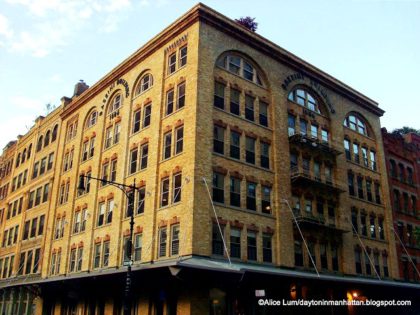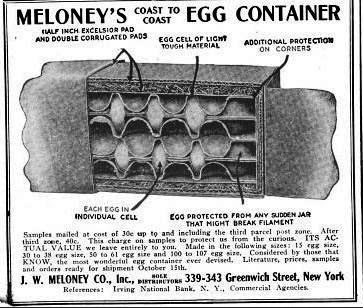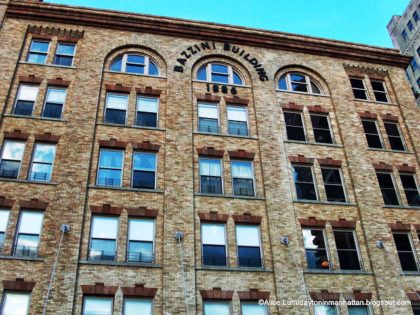The History of 339-343 Greenwich
 Tom Miller, who writes about the history of Manhattan buildings at Daytonian in Manhattan, has allowed Tribeca Citizen to create a database of his Tribeca posts. If you enjoy these, and you will, then you should definitely check out his website, which also has write-ups about buildings all over the island. And don’t miss his book, Seeking New York: The Stories Behind the Historic Architecture of Manhattan—One Building at a Time.
Tom Miller, who writes about the history of Manhattan buildings at Daytonian in Manhattan, has allowed Tribeca Citizen to create a database of his Tribeca posts. If you enjoy these, and you will, then you should definitely check out his website, which also has write-ups about buildings all over the island. And don’t miss his book, Seeking New York: The Stories Behind the Historic Architecture of Manhattan—One Building at a Time.
··································
 The members of the extended Mohlmann Family were respected wholesale grocers in 19th-century New York City, living in Greenwich Village and operating their businesses in the Washington Market neighborhood. In 1880, John H. Mohlmann began assembling a substantial building lot by buying up the small brick buildings at the corner of Jay and Greenwich Streets in the dairy and produce district. Mohlmann died before he could develop the plot; but his heirs carried on the project.
The members of the extended Mohlmann Family were respected wholesale grocers in 19th-century New York City, living in Greenwich Village and operating their businesses in the Washington Market neighborhood. In 1880, John H. Mohlmann began assembling a substantial building lot by buying up the small brick buildings at the corner of Jay and Greenwich Streets in the dairy and produce district. Mohlmann died before he could develop the plot; but his heirs carried on the project.
In 1898 the estate of John H. Mohlmann commissioned civil engineer and architect C. Wilson Atkins to design an ambitious six-story loft building. Construction began in 1899 and was completed a year later. Atkins’ building was the result of a happy marriage of Renaissance and Romanesque Revival styles. A chunky cube of buff-colored brick trimmed with brownstone, its utilitarian function played second stage to its handsome design.
The Jay Street side stretched 78 feet, three feet shorter than the Greenwich Street façade. Nevertheless Atkins somewhat surprisingly made the Jay Street elevation more imposing. Here three grand arches, four bays side, create a near-monumental look to the structure. Passersby on the wider, busier Greenwich Street saw three arches, half as large, flanked by long rectangular bays finished with brownstone corbelling. A fixed metal awning wrapped the structure at the truck level to protect deliverymen and products from the elements.
The Mohlmanns used the new building for its wholesale grocery business and leased out space to other wholesalers. One of the first tenants was not in the dairy or produce business at all. Tarrant & Co. was a wholesale druggist firm. Just as the Mohlmann building was being completed Tarrant & Co. met with misfortune. The New York Times reported that its “store was completely wrecked by fire and explosion at the corner of Greenwich and Warren Streets on Oct. 29, 1900.” The wholesalers recovered and leased space in the new building.
A similar fate struck another non-food related firm three years later. Telephony magazine reported in January 1904 that “James S. Barron & Company, New York, dealers in general electrical supplies, were burned out on April 8 [1903], suffering a loss by fire upon building and contents of $185,000, fully covered by insurance. This enterprising firm immediately opened up headquarters at 339-343 Greenwich street, where it will conduct its business until the completion of its handsome new building on the old site, which will be about May 1, 1905.
The firm was a substantial dealer in supplies for the growing electrical industry—everything from hardware for power lines and poles to battery-powered flashlights. In 1904 James S. Barron & Company advertised the newfangled flash lights in Business, the Magazine for Office Store and Factory. Full-size flashlights sold for as little as 30 cents, and “baby flash lights” for 25 cents. The “Ever Ready” electric flash lights were advertised with “no chemicals, oil, smoke or odor. No heat, matches, trouble or danger. No wire to go wrong. Useful for Clergymen, Farmers, Plumbers, Miners, Railroad Employees, Bookkeepers, Bank Employees, Hunters and Travelers…Can be carried into cellar of leaking gas, or put into keg of powder. Wind or storm will not effect [sic] the light.”
Although the Mohlmann family stayed in the building, they leased the entire structure to the Central Consumers’ Wine and Liquor Company in 1904. Despite the change in management, business continued uninterrupted for the various tenants.
One business that was interrupted, however, was that of Henry Sloane Company. The firm conducted a wholesale business in canned and frozen eggs, landing the lucrative contract for supplying the National Biscuit Company with its preserved eggs early in 1907. The business came to a sudden halt on July 18, 1907, when owner Henry Romer was arrested for “conducting his business under an assumed name and for not registering his business name with the County Clerk.”
Romer was no stranger to time behind bars. He had been arrested in Boston two years earlier by Federal authorities and extradited to Minnesota, “charged with swindling farmers in egg purchases,” according to The Sun on July 19, 1907. The newspaper said, “Romer is said to have started the Henry Sloane Company in Boston several years ago, but his partners didn’t like his business deals and got rid of him.”
Romer’s mother, Mrs. Emma Jaegers, expressed her surprise as her son’s arrest. She explained the difference in their surnames saying that “about three years ago he changed his name to Sloane, simply because he didn’t like his own name.” She apparently had no explanation of the name he was currently using.
In 1912 Goode Brothers & Kiefer Co., was here, dealing in butter. Towards the end of 1911, District Attorney Whitman eyed the noticeable rise in the prices of butter and eggs with suspicion. In January, 1912, he launched a Grand Jury investigation to look into possible price fixing on the part of wholesalers. Whitman put Assistant District Attorney Deford “in charge of the butter investigation” and on January 31, P. H. Keifer of Goode Brothers & Kiefer was subpoenaed to testify before the Grand Jury.
From around 1918 through the 1920s, J. W. Meloney Co. was here, wholesalers in “fancy white eggs” and the sole distributors of Meloney’s Coast to Coast Egg Containers. Meloney boasted it was “one of the largest dealers of white Leghorn eggs in New York.” Other butter and egg companies included Nathan Brothers, George M. Rittenhouse & Co. and Gudekieffer & Co.
 In addition to “fancy eggs” J. W. Meloney offered its own containers (American Poultry Journal, January 1921).
In addition to “fancy eggs” J. W. Meloney offered its own containers (American Poultry Journal, January 1921).
··································
The food-dealing tenants experienced labor problems in 1920 when the Food Teamsters went on strike. The union men, not content with picketing, resorted to violence and destruction of property. United States District Attorney Francis G. Caffey promised prosecutions when strike leaders threatened to destroy $1 million worth of food. He said that every man should have “liberty of employment. But if there is a conspiracy to destroy food, that is another matter and action must follow. No body of men can threaten to starve a city and get away with it.”
At 11:30 on the morning of April 15, 1920, a horse-drawn wagon owned by Goode Brothers & Kieffer Co. was attacked by about thirty-five strikers. They slashed the ropes holding the cargo and followed the wagon with its terrified driver to the Jay Street warehouse. Police were, fortunately, on hand to disperse the mob.
The company was obviously undaunted, for a month after the attack, on May 20, 1920, the New-York Tribune reported that Mrs. H. J. Mohlmann had leased the building to the Goode Brothers and Kieffer Company.
In 1943, the building was purchased by the Bazzini Family, processors and wholesalers of dried fruits and nuts. The A. L. Bazzini Company operation remained at Park Place where it was founded in 1886 and continued leasing the Greenwich Street building to wholesale food firms. Evelyn Packing Company was here at mid-century, dealing in pickled fish; while various dairy wholesalers continued to fill the building.
The Washington Market was demolished in the late 1960s when the wholesale produce industry moved far north to Hunts Point in the Bronx. Rather than follow, the Bazzini Brothers moved into their building at No. 339-343 Greenwich Street. They affixed large metal letters over the central arches of both elevations announcing “Bazzini Brothers” and the date of the company’s founding, 1886—understandably mistaken by many for the date of the building’s construction.
 The Bazzini Bros. founding date is often mistaken for the building’s construction date.
The Bazzini Bros. founding date is often mistaken for the building’s construction date.
··································
But towards the end of the century food distribution and processing was a thing of the past in Tribeca. Warehouses were converted to restaurants and residential loft spaces, and rents and taxes soared. Rocco Damato, who had purchased the Bazzini operation in 1983 with partner Jim Strong, told The New York Times in 1997 that “real estate taxes were just too high.” One of the last food processing firms in the neighborhood, it moved north to Hunts Point.
By November, 1999, the building had been converted to just ten luxury residential rental spaces. The $7 million project resulted in units ranging from 2,000 to 4,500 square feet with monthly rents in 1999 at between $7,200 to $17,000.
The robust building still commands attention, as it did in the days when canned eggs were shipped from beneath its metal awnings.
··································
Photo credits: Alice Lum.












